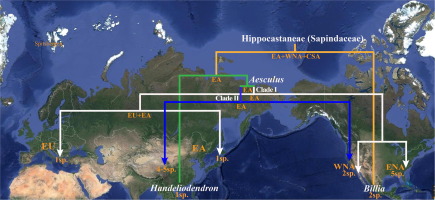当前位置:
X-MOL 学术
›
Mol. Phylogenet. Evol.
›
论文详情
Our official English website, www.x-mol.net, welcomes your
feedback! (Note: you will need to create a separate account there.)
Phylogenomics, co-evolution of ecological niche and morphology, and historical biogeography of buckeyes, horsechestnuts, and their relatives (Hippocastaneae, Sapindaceae) and the value of RAD-Seq for deep evolutionary inferences back to the Late Cretaceous.
Molecular Phylogenetics and Evolution ( IF 3.6 ) Pub Date : 2019-12-29 , DOI: 10.1016/j.ympev.2019.106726 Zhi-Yuan Du 1 , A J Harris 2 , Qiu-Yun Jenny Xiang 3
Molecular Phylogenetics and Evolution ( IF 3.6 ) Pub Date : 2019-12-29 , DOI: 10.1016/j.ympev.2019.106726 Zhi-Yuan Du 1 , A J Harris 2 , Qiu-Yun Jenny Xiang 3
Affiliation

|
In this study, we used RAD-seq data to resolve the phylogeny of the tribe Hippocastaneae (Sapindaceae) and conducted comparative analyses to gain insights into the evolution and biogeography of the group that had fossils dating back to the late Cretaceous. Hippocastaneae, including the horsechestnuts and buckeyes, is a well-supported clade in Sapindaceae that comprises 12-14 species in Aesculus, two in Billia, and one in Handeliodendron. Most species in the tribe are distributed in Eurasia and North America and exhibit a classic pattern of intercontinental disjunction in the Northern Hemisphere, while Billia occurs from southern Mexico to northern South America. The earliest fossils of Aesculus date back to at least the earliest Paleocene of eastern Asia and western North America, where there are also putative occurrences from the latest Cretaceous. The group provides an excellent system for understanding floristic disjunction in the Northern Hemisphere extending to the Neotropics. However, a strongly supported and well resolved phylogeny is presently lacking for the tribe. Previous phylogenetic studies using several gene regions revealed five well-supported clades in Aesculus, largely corresponding to five recognized taxonomic sections, but relationships among these clades and among Aesculus, Billia, and Handeliodendron were not well supported. In this study, we used RAD-seq data from 68 samples representing all clades and species of Hippocastaneae except Billia, for which we used one of two species, to further resolve relationships within the tribe. Our phylogenomic analyses showed strong support for a sister relationship between Aesculus and Handeliodendron, in contrast to previous findings which supported Billia as sister to Aesculus. Within Aesculus, relationships among sections were strongly supported as (sect. Calothyrsus, (sect. Aesculus, (sect. Macrothyrsus, (sect. Parryana, sect. Pavia)))). We found that the traditionally recognized section Calothyrsus was monophyletic, with all eastern Asian species sister to the western North American species, A. californica. Analyses of divergence times combined with biogeographic analyses suggested a Late Cretaceous origin of Hippocastaneae, in eastern Asia, western North America, and Central America (including southern Mexico), followed by isolation of Billia in Central America, extinction of the tribe ancestor in western North America, and divergence of Aesculus from Handeliodendron in eastern Asia. A Late Cretaceous origin of the common ancestor of Aesculus in eastern Asia was followed by dispersals into western North America, Europe, and eastern North America during the Late Cretaceous and the Paleogene. Our results support Aesculus as a relic of the boreotropical flora and subsequent intercontinental spread of the genus through the Bering and North Atlantic land bridges. We performed character mapping analyses, which revealed that biogeographic isolation and niche divergence may have played important roles in driving morphological evolution and lineage divergence in Aesculus. Our study demonstrates the value of RAD-seq data for reconstructing phylogeny back to the Late Cretaceous.
中文翻译:

植物学,生态位和形态的共同进化以及七叶树,七叶树及其亲属(河马科,无患子科)的历史生物地理学,以及RAD-Seq对追溯至白垩纪晚期的深层进化推论的价值。
在这项研究中,我们使用RAD-seq数据解析了河马科(Sapindaceae)的系统发育,并进行了比较分析,以了解该化石可以追溯到白垩纪晚期的那一组的演化和生物地理学。沙棘科,包括七叶树和七叶树,是Sapindaceae中得到良好支持的进化枝,在七叶树中有12-14种,在Billia中有2种,在Handeliodendron中有1种。部落中的大多数物种分布在欧亚大陆和北美,并且在北半球表现出典型的洲际分离模式,而比利娅则从墨西哥南部到南美北部出现。七叶树的化石最早可以追溯到至少东亚和北美西部的古新世,最近白垩纪也有可能发生的事件。该小组为了解北半球至新热带的植物区系分离提供了一个极好的系统。但是,该部落目前缺乏强有力的支持并得到良好解决的系统发育。先前使用几个基因区域进行的系统发育研究显示,七叶树中有五个支撑良好的进化枝,在很大程度上对应于五个公认的分类学部分,但是这些枝叶之间以及七叶树,比利亚和Handeliodendron之间的关系并未得到很好的支持。在这项研究中,我们使用了来自68个样本的RAD-seq数据,这些样本代表了除比利亚以外的河马的所有进化枝和种,我们使用了两个种中的一种来进一步解析部落之间的关系。我们的系统生物学分析表明,强烈支持七叶树与Handendodendron之间的姐妹关系,而先前的发现却支持比利亚成为七叶树的姐妹。在Aesculus中,各部分之间的关系得到了大力支持(例如Calothyrsus节,(Aesculus节,(Macrothyrsus节,(Parryana节,Pavia节)))))。我们发现,传统上公认的鳄梨属部分是单系的,所有东亚物种都与北美西部物种A. californica互为姐妹。对发散时间的分析与生物地理分析相结合,表明东亚,北美洲西部和中美洲(包括墨西哥南部)河马的晚白垩世起源,随后中美洲的比利亚被孤立,北美洲西部的部落祖先灭绝美国,和欧洲东部七叶树的七叶树的发散。白垩纪晚期起源于东亚七叶树的共同祖先,随后在白垩纪晚期和古近纪时期扩散到北美西部,欧洲和北美东部。我们的结果支持欧洲七叶树作为北冰洋植物群的遗物,并随后通过白令和北大西洋陆桥在整个洲际传播。我们进行了字符映射分析,结果表明,生物地理隔离和生态位发散可能在欧洲七叶树的形态演化和谱系发散中起着重要作用。我们的研究证明了RAD-seq数据对于重建白垩纪晚期的系统发育的价值。白垩纪晚期起源于东亚七叶树的共同祖先,随后在白垩纪晚期和古近纪时期扩散到北美西部,欧洲和北美东部。我们的结果支持欧洲七叶树作为北冰洋植物群的遗物,并随后通过白令和北大西洋陆桥在整个洲际传播。我们进行了字符映射分析,结果表明,生物地理隔离和生态位发散可能在欧洲七叶树的形态演化和谱系发散中起着重要作用。我们的研究证明了RAD-seq数据对于重建白垩纪晚期的系统发育的价值。白垩纪晚期起源于东亚七叶树的共同祖先,随后在白垩纪晚期和古近纪时期扩散到北美西部,欧洲和北美东部。我们的结果支持欧洲七叶树作为北冰洋植物群的遗物,并随后通过白令和北大西洋陆桥在整个洲际传播。我们进行了字符映射分析,结果表明,生物地理隔离和生态位发散可能在欧洲七叶树的形态演化和谱系发散中起着重要作用。我们的研究证明了RAD-seq数据对于重建白垩纪晚期的系统发育的价值。以及白垩纪晚期和古近纪时期的北美东部。我们的研究结果支持七叶树作为北冰洋植物群的遗物,并随后通过白令和北大西洋陆桥在整个洲际传播。我们进行了字符映射分析,结果表明,生物地理隔离和生态位发散可能在欧洲七叶树的形态演化和谱系发散中起着重要作用。我们的研究证明了RAD-seq数据对于重建白垩纪晚期的系统发育的价值。以及白垩纪晚期和古近纪时期的北美东部。我们的结果支持欧洲七叶树作为北冰洋植物群的遗物,并随后通过白令和北大西洋陆桥在整个洲际传播。我们进行了字符映射分析,结果表明,生物地理隔离和生态位发散可能在欧洲七叶树的形态演化和谱系发散中起着重要作用。我们的研究证明了RAD-seq数据对于重建白垩纪晚期的系统发育的价值。这表明生物地理隔离和生态位发散可能在欧洲七叶树的形态演化和谱系发散的驱动中起了重要作用。我们的研究证明了RAD-seq数据对于重建白垩纪晚期的系统发育的价值。这表明生物地理隔离和生态位发散可能在推动欧洲七叶树的形态演化和谱系发散中发挥了重要作用。我们的研究证明了RAD-seq数据对于重建白垩纪晚期的系统发育的价值。
更新日期:2019-12-29
中文翻译:

植物学,生态位和形态的共同进化以及七叶树,七叶树及其亲属(河马科,无患子科)的历史生物地理学,以及RAD-Seq对追溯至白垩纪晚期的深层进化推论的价值。
在这项研究中,我们使用RAD-seq数据解析了河马科(Sapindaceae)的系统发育,并进行了比较分析,以了解该化石可以追溯到白垩纪晚期的那一组的演化和生物地理学。沙棘科,包括七叶树和七叶树,是Sapindaceae中得到良好支持的进化枝,在七叶树中有12-14种,在Billia中有2种,在Handeliodendron中有1种。部落中的大多数物种分布在欧亚大陆和北美,并且在北半球表现出典型的洲际分离模式,而比利娅则从墨西哥南部到南美北部出现。七叶树的化石最早可以追溯到至少东亚和北美西部的古新世,最近白垩纪也有可能发生的事件。该小组为了解北半球至新热带的植物区系分离提供了一个极好的系统。但是,该部落目前缺乏强有力的支持并得到良好解决的系统发育。先前使用几个基因区域进行的系统发育研究显示,七叶树中有五个支撑良好的进化枝,在很大程度上对应于五个公认的分类学部分,但是这些枝叶之间以及七叶树,比利亚和Handeliodendron之间的关系并未得到很好的支持。在这项研究中,我们使用了来自68个样本的RAD-seq数据,这些样本代表了除比利亚以外的河马的所有进化枝和种,我们使用了两个种中的一种来进一步解析部落之间的关系。我们的系统生物学分析表明,强烈支持七叶树与Handendodendron之间的姐妹关系,而先前的发现却支持比利亚成为七叶树的姐妹。在Aesculus中,各部分之间的关系得到了大力支持(例如Calothyrsus节,(Aesculus节,(Macrothyrsus节,(Parryana节,Pavia节)))))。我们发现,传统上公认的鳄梨属部分是单系的,所有东亚物种都与北美西部物种A. californica互为姐妹。对发散时间的分析与生物地理分析相结合,表明东亚,北美洲西部和中美洲(包括墨西哥南部)河马的晚白垩世起源,随后中美洲的比利亚被孤立,北美洲西部的部落祖先灭绝美国,和欧洲东部七叶树的七叶树的发散。白垩纪晚期起源于东亚七叶树的共同祖先,随后在白垩纪晚期和古近纪时期扩散到北美西部,欧洲和北美东部。我们的结果支持欧洲七叶树作为北冰洋植物群的遗物,并随后通过白令和北大西洋陆桥在整个洲际传播。我们进行了字符映射分析,结果表明,生物地理隔离和生态位发散可能在欧洲七叶树的形态演化和谱系发散中起着重要作用。我们的研究证明了RAD-seq数据对于重建白垩纪晚期的系统发育的价值。白垩纪晚期起源于东亚七叶树的共同祖先,随后在白垩纪晚期和古近纪时期扩散到北美西部,欧洲和北美东部。我们的结果支持欧洲七叶树作为北冰洋植物群的遗物,并随后通过白令和北大西洋陆桥在整个洲际传播。我们进行了字符映射分析,结果表明,生物地理隔离和生态位发散可能在欧洲七叶树的形态演化和谱系发散中起着重要作用。我们的研究证明了RAD-seq数据对于重建白垩纪晚期的系统发育的价值。白垩纪晚期起源于东亚七叶树的共同祖先,随后在白垩纪晚期和古近纪时期扩散到北美西部,欧洲和北美东部。我们的结果支持欧洲七叶树作为北冰洋植物群的遗物,并随后通过白令和北大西洋陆桥在整个洲际传播。我们进行了字符映射分析,结果表明,生物地理隔离和生态位发散可能在欧洲七叶树的形态演化和谱系发散中起着重要作用。我们的研究证明了RAD-seq数据对于重建白垩纪晚期的系统发育的价值。以及白垩纪晚期和古近纪时期的北美东部。我们的研究结果支持七叶树作为北冰洋植物群的遗物,并随后通过白令和北大西洋陆桥在整个洲际传播。我们进行了字符映射分析,结果表明,生物地理隔离和生态位发散可能在欧洲七叶树的形态演化和谱系发散中起着重要作用。我们的研究证明了RAD-seq数据对于重建白垩纪晚期的系统发育的价值。以及白垩纪晚期和古近纪时期的北美东部。我们的结果支持欧洲七叶树作为北冰洋植物群的遗物,并随后通过白令和北大西洋陆桥在整个洲际传播。我们进行了字符映射分析,结果表明,生物地理隔离和生态位发散可能在欧洲七叶树的形态演化和谱系发散中起着重要作用。我们的研究证明了RAD-seq数据对于重建白垩纪晚期的系统发育的价值。这表明生物地理隔离和生态位发散可能在欧洲七叶树的形态演化和谱系发散的驱动中起了重要作用。我们的研究证明了RAD-seq数据对于重建白垩纪晚期的系统发育的价值。这表明生物地理隔离和生态位发散可能在推动欧洲七叶树的形态演化和谱系发散中发挥了重要作用。我们的研究证明了RAD-seq数据对于重建白垩纪晚期的系统发育的价值。











































 京公网安备 11010802027423号
京公网安备 11010802027423号